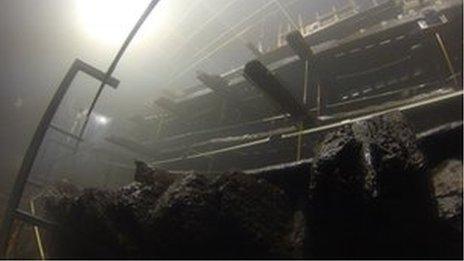Mary Rose protective jets switched off for first time
- Published

Conservation work to remove 100 tons of water from the hull of the Mary Rose will take up to five years
Jets used to spray the hull of Henry VIII's flagship the Mary Rose have been switched off for the first time in almost 30 years.
The warship's hull has been constantly sprayed with water and wax chemicals since it was raised from the seabed.
Work to remove 100 tons of water from the hull could take up to five years.
The hull will be kept in a "hot box" chamber but visitors to Portsmouth Historic Dockyard will be able to view it through windows from 31 May.
'Treasured artefact'
Inside the airtight chamber conditioned air will be directed at the hull to gradually remove water from the wood, dry and preserve it.
Mark Jones, head of conservation at the Mary Rose Trust, said: "It really will be a unique chance for visitors to see our team preserve a treasured artefact as they can see through windows into the "hot box" containing the Mary Rose when the new museum opens."
The 16th Century hull was first sprayed with chilled fresh water to remove salt and later with a water-soluble wax which prevents shrinkage of the timbers.
The spray jets have now been switched off four weeks from the official opening of the Mary Rose Museum before the hull undergoes the technical drying process.
The new museum finally reunites the Mary Rose with thousands of the 19,000 artefacts raised from the wreck.
The bulk of the £35m funding for the museum and conservation project came from a £23m Heritage Lottery Fund grant, with remaining cash raised through various charitable trusts, fundraising and sponsors.
The Mary Rose saw 34 years of service before she sank while leading an attack on a French invasion fleet in 1545, and was raised 437 years later on 11 October 1982.
King Henry VIII watched from Southsea Castle as his ship sank killing all but 35 of the 500-strong crew.
- Published2 April 2013
- Published13 February 2013
- Published30 January 2013
- Published18 November 2012
- Published11 October 2012